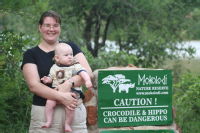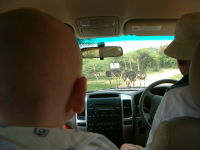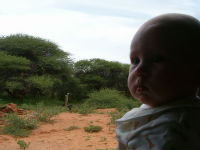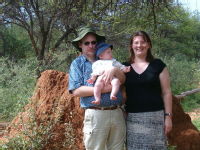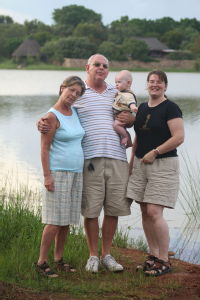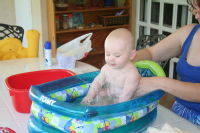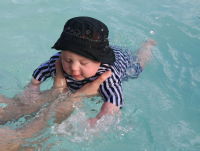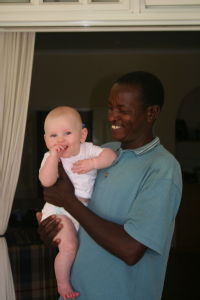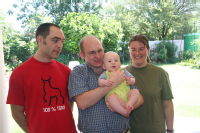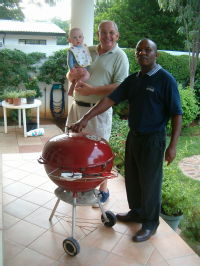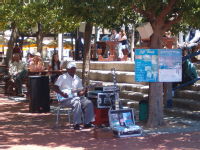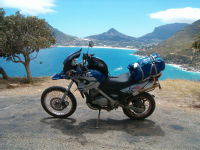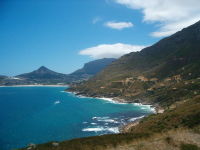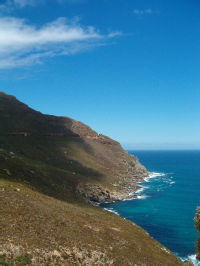All 59 entries tagged Bmw Gs
No other Warwick Blogs use the tag Bmw Gs on entries | View entries tagged Bmw Gs at Technorati | View all 24 images tagged Bmw Gs
December 08, 2006
100,000 miles on two wheels – the good, the bad and the ugly
Follow-up to More surprising facts about motorcycling from Transversality - Robert O'Toole
The good:
- Just going around any fast and wide sweeping corner with excellent grip and visibility.
- Heavily scented country air being forced through the vents at the front of my helmet.
- 0-60 in 5 seconds on a 15 year old trail-bike, 0-60 in 3.5 seconds on a new Ducati.
- Overtaking a Porsche Boxster out of a right hand bend.
- Every time a complete stranger on a bike signals hello (nod of the head in the UK, wave in SA, shake of the leg in continental Europe).
- Filtering past a Maserati stuck in a mile long line of cars, millions of pounds worth of vehicles, all going nowhere – fools!
- Riding a twisty mountain road with an incredible view, locations including the Pyrenees, Montserrat, Auvergne and Chapman’s Peak Drive in Cape Town.
- Crossing France in a day on back roads.
- Riding dry dirt roads in southern Europe or South Africa.
- Kick starting a BMW 1000cc transverse twin.
The bad:
- Being hit on the head and knocked out by debris at 85mph on the motorway in Catalunya (glad I wasn’t driving a car, it would have come straight through the windscreen).
- Hitting a dead swan at 80mph in the middle lane of the M40.
- Dodging past sheets of glass falling off the back of a lorry on the M40 (I passed the lorry and stopped it).
- Being blown off a motorway while riding an F650 in heavy wind.
- Exhaust valve burn out in the outside lane of the motorway.
- Riding on motorways, especially the Paris Peripherique.
- Falling off in deep mud, glamorous locations including Salisbury Plane, the Ridgeway in Oxfordshire and the Karoo desert.
- Riding at 90mph in the outside lane of a French motorway, and being overtaken by a car with half of its wheels off the road.
- Diesel spills, especially around Warwick University (blame the bus company?)
- Car drivers, van drivers, caravaners.
And the ugly:

..the Moosehead biker gang (notice the complete absence of functioning motorcycles).
December 07, 2006
More surprising facts about motorcycling
Follow-up to Mike Waite – motorcycle roadcraft instructor from Transversality - Robert O'Toole
Some other facts about riding a motorcycle that will surprise car drivers:
- We tend to avoid using our brakes, especially as we enter corners. Bikes have five or more gears and usually a clutch that offers lots of subtle control and feedback. Engine braking is the effect that occurs when changing down a gear. Whereas the powerful front brake on a bike upsets its balance, subtle engine braking slows it down whilst maintaining balance. Some riders also gently touch the brake lever whenever they slow down, so as to warn following drivers.
- Filtering (moving to the front of a line of traffic) is both legal and encouraged by the police system. Of course it can be dangerous, but like most things in motorcycling, there are a whole set of techniques designed to make it safe.
- The majority of motorcyle accidents are not caused by car drivers (the so called SMIDSY or “sorry mate I didn’t see you”). They happen on corners, and are associated with poor cornering technique and too much speed. Using the visual point system aims to eliminate these dangers.
- Our roads are often covered in a film of spilt diesel. This emenates from poorly maintained or over-filled commercial vehicles. In the wet it can be a major threat to bikes. However, it also causes many car accidents. Car drivers are so isolated from the environment that they have no idea why they suddenly lose control. The majority of car fatalities are now caused by “sudden loss of control”.
- Motorcycles are neither cheap nor environmentally friendly. The average fuel consumption is around 40pmg. Sports bikes are as low as 25mpg. Tyres rarely last longer than 10,000 miles, and cost around £100 each. A full service for my BMW costs over £400. It is serviced every 5000 miles. My riding equipment, with armour, cost around £1000.
- Harley Davidson’s are not cool.
- Zen and the Art of Motorcyle Maintenance is nonsense. However Jupiter’s Travels is really great literature.
- Valentino Rossi is a god. Schumacher is a pointless bore.
- The first vehicle to cross the entire American continent on land (except for rivers) was a BMW R100 GS.
- The last vehicle to cross Siberia before global warming makes it impossible will probably be a BMW R1200GS Adventure.
Oh, and of course Ewan McGregor is genuinely hard.

And Charley Boorman? Well he had to put up with a lot.
Mike Waite – motorcycle roadcraft instructor
Follow-up to Being assertive and visible on the road – roadcraft for motorcyclists and cyclists from Transversality - Robert O'Toole
Mike Waite is one of the UK’s most respected instructors. I’ve not ridden with him, but I have heard good reports about his team. Not only does he run advanced training courses using the police roadcraft system, he also has a very good DVD for sale. See Mike’s web site for details.
The web site contains some extracts from the video, as well as some footage recorded from his training sessions. Watch a sample below (click on the triangle to make it play). If you have never ridden a big bike, you will be surprised at just how much technical skill, constant observation and intelligence it requires (if you want to stay alive). There is little comparison with driving a car. Note how the manouverability of the bike is used to its maximum, not only to maintain a safe position, but also to gain a better view of the road.
You will also hear Mike constantly talking about the visual point. This is the point at which the road disappears from view. Riders spend most of their time tracking the visual point. The movement of the point away to the left and to the right indicates the nature of upcoming bends. Also hear how Mike picks out features in the landscape such as telegraph poles and hedges. This is used to infer further information about the road. Modern bikes are so fast and so manouverable that such constant observation and planning is essential.
December 05, 2006
Being assertive and visible on the road – roadcraft for motorcyclists and cyclists
Follow-up to Cross in 3 seconds or you're dead – cycling to Warwick University from Transversality - Robert O'Toole
Recently I mentioned my approach to travelling on the roads:
“I am certainly capable of dominating the road and controlling the drivers”
This is easily misunderstood. It isn’t aggresive at all, it’s about being assertive and visible, but polite.
I follow roadcraft, the police motorcycling system. I have done training in the system, and spend a couple of hours every month practising. It works well. I’ve spent most of my time on two motorised wheels. The system has kept me confidently safe for 100,000 miles (apart from the occasional unavoidable collision with motorway debris). The important point is that it isn’t about aggresion, it is very controlled and considered. It relies on constant information given to other road users, with lots of thank you waves. It is all about being assertive and visible in order to counter the mind–dulling driver psychology that is such a danger to other road users.
Here’s an example: consider the turn into Westwood (the second turn towards Coventry). Can you spot something really dangerous about that junction? The pedestrian refuge just before the junction is placed too close to the junction. This means that if you are turning into Westwood, and have to stop mid turn (due to a pedestrian or some other obstacle), the car behind you will have no where to go. As most motorists do not leave a sufficient gap, there’s a good chance you will get shunted. Most car drivers are surprised by the fact that a motorcycle goes around such a corner significantly slower than a car (for various reasons). So the problem is even worse for motorcyclists. Rear end shunts represent a growing percentage of all bike accidents.
And the answer: control the following cars before you get to the junction. Firstly, get your brake light on early. Then gently slow until the following car is closer, the following car will then be travelling at the same speed. You can then control the speed of the following car so that you can enter the turn at a safe speed without any chance of being shunted. I can give you hundreds of other examples. It’s how you take a potentially dangerous method of transport like motorcycling and make it safer than any other form of transport.
I think many of these principles transfer to cycling. Obviously a cycle has less presence on the road, but the system remains the same:
- Take information.
- Use information (that means think and plan, something that most motorists fail to do).
- Give information (make sure it has been seen and acknowledged – eye contact!).
- Position (getting the required space around you on the road, this is the assertive and confident bit).
- Speed (not so easy on a bike, unless you are Chris May).
- Gear (not so relevant on a bike).
- Accelerate and manouvre.
And say thank you if appropriate.
To get started, read the roadcraft manual There is also a version for car drivers. I wonder if there is an equivalent for cyclists?
And then get trained. You can get advanced motorcycle training from RoSPA, the IAM, and the local police (Bike Safe Training). They all use the police method.
November 22, 2006
Exhaust[ion]
This is what it should look like…
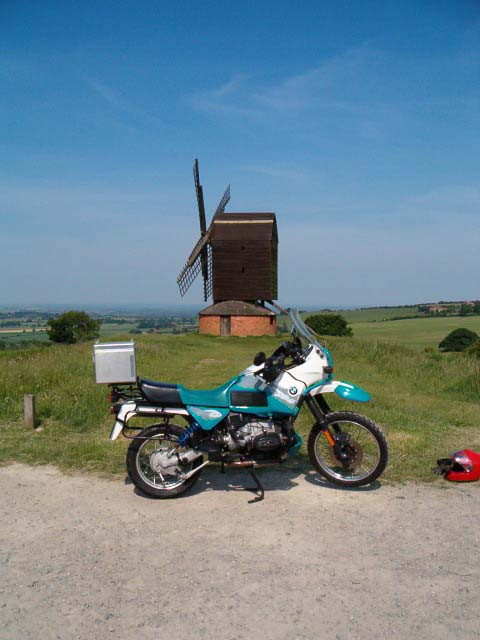
...a bike capable of crossing continents. Unfortunately at the moment it would struggle to cross the driveway…
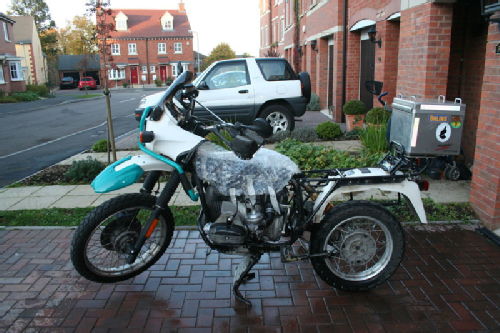
After 78,000 miles, mostly in harsh conditions, it needed a complete strip down. These bikes are capable of massive mileage, but as with any metal object, require occasional TOTAL REFURBISHMENT! Rust has begun to set in. The two most effected components being the lower fork-brace (i think that’s what it is called)...
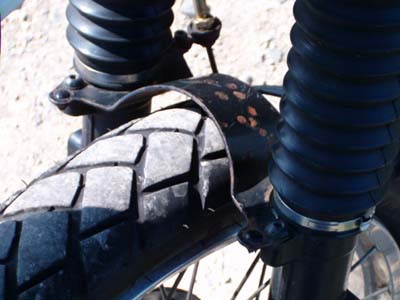
And the battery cage. To start with, I removed them and stripped the rust and paint. The fork-brace was easily re-sprated with Hammerite…
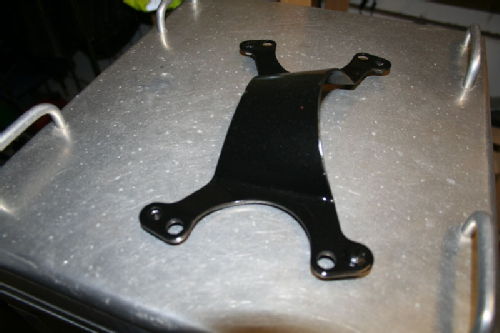
The battery cage is being given an anti-rust treatment before being painted. Removing the battery cage revealed some alarming rust on the Ohlins shock absorber, which cost me £800 only 20,000 miles back…
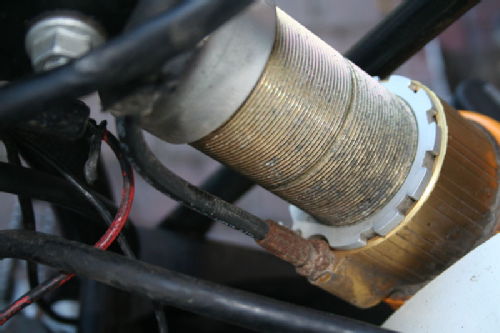
One of the great things about the R100 GS Paris Dakar is that it was designed to be worked on out in the cuds. The tank and seat clips off in seconds, and the few body panels and crash protectors are cleanly bolted in place. If only removing the exhaust system were so easy. I need to take them off to get at the sides of the lower part of the engine. The down pipes also desperately need replacing, with holes starting to appear in the left hand pipe. The struggle was mighty and prolonged. The down-pipe nuts came off quickly, using the special BMW tool…
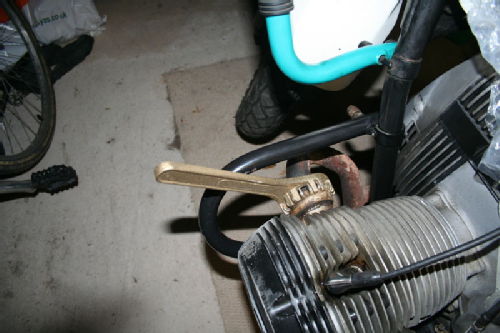
This was good news. No serious force can be used to remove them, as this would strip the thread on the engine (expensive). I had expected to be able to simply pull out the down-pipes as a pair, but unfortunately they were seized into place. To progress further I removed the silencer (and attached pannier frame), with the Y-piece still attached. I then tried to seperate the two down-pipes at their crossover. Unfortunately, the left pipe was seized into the crossover. However, it was so rusty that it started to disintegrate. I had no choice but the snap it in half, leaving a rusty shell within the end of the Y-piece, to be dealt with later. Once this was done, I could carefully twist the down-pipes out of their ports.
Here’s the broken down-pipe…
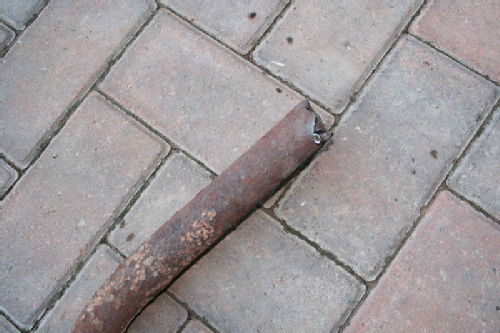
With the pipes off, I could inspect the state of the lower part of the engine. What a mess! It looks as if at least one push-rod seal has blown. This would explain the disappearing engine oil.
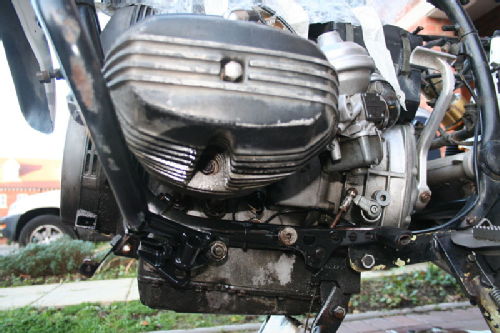
After covering up the open exhaust ports and the electrics, I started to apply Gunk engine degreasant. The first application had only a small effect…
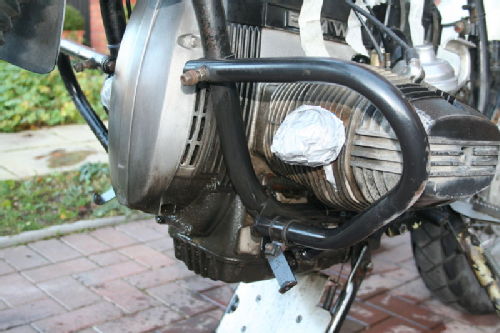
I now have to get all of that gunge off, and then start cleaning the black dirt out of the pitted surface of the engine. I will also use Autosol to give a shine to everything. The frame has more rust than expected, so that will need to be treated as well.
And this is only the start! The pushrod seals need to be replaced. I suspect that a new timing chain is also required. This is all only a temporary fix. Next year I plan to get it professionaly refurbished and powder coated.
August 08, 2006
A seizure, a bypass, and a very fast bike
How many goats must be sacrificed before beginning the starting procedure? In these modern politically correct times we no longer sacrifice virgins. Goats yes: messy but legal. Virgins no: messy, illegal, very much so. Such bloodlettings are only one of many requirements:
- check the petrol taps are on;
- estimate the exact degree of choke using a complex algorithm combining the ambient air temperature with the quantity of oil in the sump and the latent heat in the pistons (or just guess and get it wrong);
- put the bike on its centre stand;
- pray to the correct pantheon of Germanic gods;
- sacrifice goats (not virgins);
- sign Satanic pact (in blood) henceforth dedicating one's soul to the Antichrist;
- mount BMW motorcycle;
- place heal of boot onto the kick starter;
- gently pump the kick starter up and down for anything up to half an hour;
- be amazed when sufficient compression is generated in the 1000cc lump so that firing commences;
- rev the engine at exactly the right time in exactly the correct manner so as to keep the cylinders firing;
- don't ever stop reving the engine until it is thoroughly warmed up (ten miles of riding is usually sufficient).
Starting a 13 year old BMW R100 GS Paris Daker desert racer without an electric starter motor is a fairly futile task. But occassionaly, thanks to BMW reliability, the task is unavoidably necessary. A single click from the ignition system had made the situation quite clear. The starter had seized. This might have been a side effect of a high speed 200 mile non–stop blast between Kenilworth and Dorchester the day before. But I suspect that the bike just realised that it was only 10 miles from its spiritual home (the dealer from whence it came). It is often uncanny in this manner.
And so, only a few minutes after deciding to give in and buy myself one of the wonderful new R1200GS rocket bikes, I was again back on track. Had I been riding a modern bike I would still be waiting for the tow truck. The R100GS was one of the last bikes to be equipped with a kick start, the idea being that electrics do fail quite easily when riding far out in its natural environment, the Sahara.
My arrival at CW's caused a minor stir. The GS–PD is a rare sight. Wally, top technical man, had come in specially to supervise work on what seems to be one of his favourites. In the past he has replaced the gearbox, shaft drive, brakes, one exhaust valve, and various other bits under warranty. Now being out of warranty (over ten years old), I would have to pay for a new starter motor myself: £175. I would also have to wait for a few days – not part of my agenda. Wally is also recommending that he fit a bypass to cut out the oil cooler, which is now rather old and a potential problem. Common wisdom claims that the cooler isn't really required, unless riding in the desert, and in fact the engine runs better without it. I have given him a Touratech bypas kit to apply.
Having amazed everyone with my kick–start miracle, I sat down for a while to chat with Wally and Neil. Wally has a theory about kick starting: it is a genetically inherited skill, or rather, some kind of primeval drive. Some people have it, other don't. He also claims that it guarantees success with the ladies! I'm not sure about that. But it certainly did get me tio CW's, from whom I departed a couple of hours later riding a loan bike. A very fast loan bike: a new R1150R naked roadster on which I could bimble around Dorset, ride back to Kenilworth, and then return in a few days to collect the GS PD. Excellent service as usual.

BMW R1150R – a sexy black naked roadster. Fast, manouverable, moderately comfortable (legs a bit too cramped). I even managed to get the front wheel to slide in a corner. The telelever front suspension is often blamed for this habit – it makes the bike much more stable, but also isolates the rider from the traction, making it hard to know when it is losing grip.
May 07, 2006
My Oxford top 10
- The Radcliffe Arms, Jerico. A very ordinary, old–fashioned and down–to–earth pub in one of Britain's most expensive neighbourhoods. Good beer, and good cheap food. Excellent for Sunday roast.
- Walking along the Thames into Oxford, from the Abingdon Park and Ride to the Head of the River pub. On weekend mornings you can see boat crews exercising out on the river. From the pub, you can continue through Christ Church Meadows to the Botanical Gardens, and then across to the Parks and out the other side of Oxford. There is a bus back to the Park and Ride from the city centre.
- Walking through Port Meadow from the Botley Road to the The Trout Inn. The water meadow is an interesting environment, with lots of open space and lots to see. A good place for a picnic, except for the hordes of angry political geese
- Borders coffee shop. Each of the three book shops in Oxford have good cafes. However, the Borders cafe is right next to the philosophy section, which contains a decent selection of interesting books, often with plenty of Deleuze.
- Edamame, 15 Holywell Street. A tiny Japanese restaurant serving what I am told is the kind of food that the Japanese really eat (ie not sushi). We first went there with a friend who has lived in Japan. The food is excellent, although the seating system is very un–English. You have to share your table with anyone else seeking a space.
- The Fishes pub and restaurant in North Hinksey. Next to a small river, with a large garden and a play area for Mooseheads. Excellent and sensibly priced food. It has been refurbished recently, so may have changed.
- The Aziz. 230 Cowley Road. Of Oxford's many good Indian Restaurants, this is my favourite. Good friendly service, even for large groups of drunken e–learning advisors.
- Oxford Coffee Concerts at the Holywell Music Room. Concerts of classical music, Sundays 11:15.
- Oxford University Museum of Natural History. Free entry. Voracious dinosaurs.
- Moosehead Manor, Botley. Exclusive club for learning technologists and other miscellaneous flotsam. Luxury accommodation. Entertaining host, speaks Russian, Romanian, Portuguese and English (when sober). Vast array of kitchen gadgets. Endless supply of scotch bonnet chillis. Fascinating and colourful history. Opposite Andy Brock's butchery, hence ideal for serious fry–ups.
February 18, 2006
Travel Report: Underwater Africa
Follow-up to Travel Report: Lawrence on safari from Transversality - Robert O'Toole
Our swimming teacher claims that babies keep their eyes open under water. Lawrence doesn't agree:
Whilst on holiday, he swam every day. Soon he had begun to kick his feet and use his arms. He is also capable of easily keeping his head above water.
February 13, 2006
Travel Report: Lawrence on safari
Follow-up to Travel Report: Lawrence of Africa from Transversality - Robert O'Toole
Steve Irwin says it's perfectly safe…
"Faster, faster, make them fly…"
"Daddy, why have those trees got eyes and beaks?"
…and seconds later the 20 foot long crocodile lept out of the water.
Travel Report: Lawrence of Africa
Follow-up to Travel Report: Penguin flu and giant crabs in Cape Town from Transversality - Robert O'Toole
It was a hard flight from Cape Town to Jo'burg, and then from there to Gaborone. On arriving at the ranch I found young Lawrence, who it seems had spent a week sitting in his jacuzzi on the patio…
…with the occassional swim in the pool…
…after a hard day's work running the government…
…and meeting many new friends…
At least he helped the two Peters to cook goat for my birthday…
February 12, 2006
Travel Report: Penguin flu and giant crabs in Cape Town
Follow-up to Travel Report: Simon's Town day 2, and Cape Point from Transversality - Robert O'Toole
After seven great days of touring, I rode back over the Cape Penninsula and onto the big highways leading through the sprawl of Cape Town to the Victoria and Alfred Waterfront, ending my journey at the BMW showroom where it had begun. I returned the bike to Celia of Karoo Biking, who bemoaned my bad luck in the Karoo mud, and seemed to agree that the damage was not too bad or expensive (more on that matter later).
This seemed like a good time to collapse with exhaustion, so I did, falling into the hospitable arms of BMW (free coffee, comfy chairs). Most friendly of all was the head of security, who pointed me in the direction of a good hotel nearby, and arranged for my equipment to be transfered by taxi.
Protea Breakwater Hotel at the University of Cape Town
The hotel to which I was directed proved to be a great choice. It was a little confusing at first. I had booked into a Protea three star hotel. I found myself within the rather luxurious campus of the University of Cape Town Business School. And yet the building had the appearance of a prison…
…quite a pleasant prison…
…which it had in fact been for a short period of time. This reminded me of the importance of the prison system within the history of South Africa, a subject that I had discussed with Elizabeth in Simon's Town. And the links between that culture, the colonial administration, poor laws in the UK, and the concentration camps.
But this was no longer a place of punishment, rather a place of learning and luxury accomodation combined. The UCT had clevely allowed a leading hotel chain to take over the accomodation business within its best campus. And it certaintly was doing a good job of it. For under £50 I got this view from my window…
…and a short walk away…
Unfortunately, I was unable to enjoy myself fully, having contracted some hideous sickness which I suspect was linked to swimming with penguins.
The following day, before returning to the airport, I visited the Two Oceans Aquarium, next to the hotel. Despite being in a weakened state, I managed to be impressed by the many fishy exhibits, including giant crabs as big as a labrador, and scuba divers cleaning the tanks…
And that was it. I returned to Cape Town International airport to board the first of my two flights to take me up to meet Emma and Lawrence in Gaborone, Botswana.
Travel Report: Simon's Town day 2, and Cape Point
Follow-up to Travel Report: Simon's Town day 1 from Transversality - Robert O'Toole
Riding to the end of Africa
In the morning of my second day I rode further south along the penninsula, as far south as is possible, right to the end of Africa. In fact there is a more southerly point, but the Cape Point nature reserve is considered to be special. The large wild area that occupies this part of the Cape is certainly worth a visit, with its pristine fynbos landscape and animals, including baboons, ostrich and bontebok antelopes. It is also a good sea watching platform, with sightings of many kinds of cetacean possible.
History
Later in the day I returned to the harbour. The many interesting small shops were now open, including art galleries presenting a wide variety of innovative work. I again sat in the restaurant admiring the view…
In the afternoon I had a fascinating appointment. Elizabeth van Heyningen of the University of Cape Town is a leading expert on South African history, currently working with Iain Smith of Warwick on the historical database project Morbidity and Mortality in the Concentration Camps of the South African War, 1899-1902 She is also a resident of Simon's Town. It was therefore an ideal opportunity to meet up with a historian doing work related to that in which I am involved in England. Elizabeth proved to be full of fascinating insights, not only regarding methods of historical research using computers, but also the many interesting topics that we dicussed over coffee.
I had a great time finding out about South African history, Simon's Town and its people, and how this all connects with and shapes the politics of today. Elizabeth proved to be a charming and clever lady. The meeting left me with a greater understanding of the importance of projects such as that on the concentration camps, and a determination to support more such activities in England. I hope to meet up with her when she comes to Warwick later in the year, and intend by then to have much positive news to report concerning databases in history.
Last lunch in Simon's Town
Later that evening I sampled yet more of the delicious sea food, this time a "fisherman's platter" of hake and calamari…
I reflected on Simon's Town, and just how surprised I had been about it. I have, I believe, never been anywhere quite so relaxed. One can easily walk around the town without fears, even at night. People are friendly and welcoming, and there is plenty of interest, including several museums that I failed to visit. On passing the tourist information office, I stopped to assemble a collection of leaflets advertising cottages to rent. My plan is to return soon with Lawrence and Emma.
Return to Cape Town
The following morning, on my way back to Cape Town, I had planned to take a boat trip into the bay, with the hope of seeing sharks and dolphins. Unfortunately, that night a fierce wind blew up, and by the morning the surface of the sea was far to rough. I proceeded instead on to the big city, stopping to get the bike washed ready for its return to Karoo Biking. It was still carrying a heavy load of Karoo mud…
Travel Report: Simon's Town day 1
Follow-up to Travel Report: Boulders Beach in close up from Transversality - Robert O'Toole
For my first morning in Simon's Town, I revisited the penguin colony. It promised to be a fine hot day, perfect for swimming, and perhaps a boat trip into the bay. Some good photographs were taken…
I walked along to the National Parks Board information centre, which offers exhibitions and a shop, as well as a screen showing a movie about the invasion of the penguins. I sat down for half an hour to watch the show, revealing just how far the penguins have gone in taking over the town.
Once the show was over, I walked out of the TV room and back into the sunlight…sunlight?...confusion! Within thirty minutes a heavy sea fog had engulfed the bay. The land was wet, and the sky dark. As it wasn't actually raining, I decided to continue my walk into town. The mist cleared a little, but by the time I reached the restaurants, I was quite damp.
I sat down overlooking the harbour, and ordered a cape malay line fish curry – "line" referring to the method of capture. This is a common feature of Cape menus, and usually indicates that the meal comprises of whatever fish had been brought in that morning, In this case it was angel fish, with delicate but substantial white flesh. The cape malay curry, in this case slightly hot, is a traditional sauce with a degree of sweetness typical of cape cooking.
Looking out across Simon's Bay, I could see vessels of the South African navy, docked in their home port. Almost 190 years ago, the same anchorage would have been occupied by the wooden sail boats of the Royal Navy's South Atlantic squadron, charged with the task of keeping the French and Dutch out and, more importantly after the fall of Napolean, of putting an end to the slave trade.
By the time that I had walked back to my rondavel, the weather had started to clear and the sun had broken through the clouds.
Part 10, Simons Town and Cape Point
Travel Report: Boulders Beach in close up
Follow-up to Travel Report: Big skies into Cape Town from Transversality - Robert O'Toole
The Cape Peninsula curves out into the Atlantic Ocean like a great arm, catching passing marine life in its grasp. To its east, False Bay provides shelter and a few vital degrees of warmth. Dolphins, whales, sharks, sea-birds and humans enjoy its waters and beaches. Of the many settlements along the mild coast of the bay, Simon's Town stands out for a unique combination of reasons. As a finale to my trip, I planned to stay for a couple of days, renting a small rondavel (thatched hut) in the well kept Caravan and Camping park.
If that sounds like rather humble accomodation, consider the views available within just a one minute walk…
And the neighbours, who employ rather unusual security guards to man their gates…
For the southern end of town is home to one of the world's most famous beaches, Boulders…
During the hours of darkness, I discovered, the penguins roam freely. I seemed to be surrounded with them and their strange braying calls. You may recogise them as of the sub-species Jackass, a most appropriate name. That is now considered by the penguin-naming authorities to be some kind of insult. And so as with many things in South Africa, they are renamed: the African Penguin. The birds themselves don't care. They know who is in charge in this town, and neither nomanclature nor penguin-proof fences will stop them.
Besides, we humans get our own back, both through overfishing and through the less serious persecution of the tourist camera…
The reward for us may be that perfect souvenir snapshot…
Or the childhood memory of a game of penguin netting…
But remember these are sensitive creatures, and if you try to walk like a penguin…
They may well confront you for your mockery…
Signs dotted around this National Parks Board managed beach warn that penguins can bite, but more usually they just retreat into the sea…
They do, after all, have a much nicer beach reserved for their own use…
What a marvellous place for both penguins and people.
February 11, 2006
Travel Report: Big skies into Cape Town
Follow-up to Travel Report: Bathtime in the Western Cape from Transversality - Robert O'Toole
I could imagine the Atlantic to the west, a fiercely constant and cold generator of weather and fate, as I descended the N7 from Citrusdal, down towards the Cape. Imperceptibly the trickle of tarmac, eroding at the edges, filled out with the signs of approaching civilization. At some point a hard-shoulder emerged as the bush retreated. The road markings became more distinct. The rustic padstaals were displaced by modern service stations of international quality. But despite all of this, a geographical and meteorological sense kept me in my place: Africa, being funneled down to its point of disappearance, the Cape of Good Hope, with the turbulence of the cross-wind from the west hitting the mountains to the east. And me on a small bike being bounced around my path, fighting to keep moving on the desired line.
At around the half way point I pulled across the road and into a whole new world: a smart new Caltex station with a Wimpy restaurant and an extensive convenience store. I went straight to the Wimpy. My need for liquid was greater than that of the bike. Riding through such hot dry wind has a dehydrating effect, and I had found that I could go for only half an hour before stopping for a drink. I bought a big cold glass of guava juice, and wandered up and down in front of a TV showing cricket. Returning to the bike, I found a couple of boys inspecting it closely. The usual questions followed, which were however not met with the usual wonderment. It seemed that for any given feature of either the bike or the journey, daddy could do better. For the required evidence, they pointed to a new luxury 4×4 with a trailer full of quad "bikes". At which point, if I could have been bothered, two-wheel-only snobbery could have been my response, there being neither skill nor adventure in such a leisure pursuit. Daddy actually turned out to be not so bad. In fact with typical South African hospitality he gave me his business card and invited me to ride on his dirt track sometime.
Back onto the highway, a little further along, the restaurant and the rich white kids were easily forgotten. I descended a gentle hill and entered a wide plain. The sky darkened ahead of my direct path. Evidence of a rain storm was obvious on the horizon. To the west I could see a gap in the weather. And then further again to the west more rain. The regions of rain and shine were so distinct as to resemble a weather map, but viewed in three dimensions from below. My summer motorcycling clothes, including a Taureg desert jacket, now promised to be inadequate. I hadn't packed even lightweight waterproofs, having expected to be riding in the Western Cape dry season. However, rain at Algeria, Brandvlei, Vanrhynsdorp and Baths had taught me that this was no normal season.
I anticipated a soaking for what seemed like half an hour. It would not be too bad, I decided. In this climate rain might even be enjoyable, although I was nervous of how it might affect the Metzeler Sahara tyre on the front wheel. And then just as I had settled on the benefits of the wet, the road turned to the west, with a degree of determination heading for the gap in the weather. Rainstorms sat on the horizon of my peripheral vision whilst my view far along the road struggled with a dazzling light.
After some time riding along this trajectory, a vast flat-topped grey shape appeared in silhouette far away.
This and many similarly grand geographies represents a third of what attracts me back again and again to Southern Africa. A second such proportion of this fascination includes the complex fine detail of the land when experienced in close-up: the people, wildlife (big and small) and the plants. The third portion consists of the irreducible convulsions and foldings between these two scales, the grand and the miniature, the geological and the personal: the eruptions of chaos and senselessness that form the history of the land as people adapt to or resist its flows and formations. My journey had worked on all three of these scales. Now my passage through the wide plains and their weather, with Table Mountain as its growing focus, acted to draw the details of these events out into my memory, giving time and space for it all to negotiate some kind of settlement as the journey.
Of course I cannot claim that my small meander was much of a diagram connecting and carrying with it a multitude of diverse points spanning a whole continent. But I do think that even a small abandonment to the laws of deterritorialization is worthwhile as a means of thinking through space and time (call it geophilosophy). This may not have been possible if it were not for the far more extensive travels, adventures and ideas of another motorcyclist and writer. And as Table Mountain grew in scale, I paid homage to that journey:
My joy is almost hysterical as I park the bike, walk slowly over the paving towards a cafe table and sit down. I have just ridden that motorcycle 12,245 miles from London, and absolutely nobody here, watching me, knows it. As I think about it I have a sudden and quite extraordinary flash, something I never had before and am never able to recapture again. I see the whole of Africa in one single vision, as though illuminated by lightning. And that's it. i've done it. I'm at peace. (Ted Simon, Jupiter's Travels, Penguin 1990, p.183)
…uncountable and irreducible points across a continent connected in a single moment, a single line or diagram of deterritorialization.
The highway doubled in size. Traffic grew slightly more angry and urban. The N7 became the N1. And finally I reached the Cape Town waterfront for a rest.
I found a drink and a lively crowd listening to a guitarist outside of the great shopping mall on the Victoria and Alfred Waterfront. At first I assumed that he was a busker. Only later did I discover that he manufactures unique electric guitars out of old drinks cans, for sale expensively in the V&A craft market.
But the journey didn't end there. With three days left, I had more points to connect.
After half an hour's rest, I was back on the road to cross the Cape peninsula for Simon's Town. To get there I followed the coastline heading south along the west. I passed luxurious hotels and busy beaches packed with bathers and policemen. The water already looked an unreal shade of blue. The colour and sense of disbelief deepened as I rode upwards and onto the coast road known as Chapman's Peak Drive. This is unarguably one of the world's great roads. Between Noordhoek and Hout Bay, with the Lion's Head mountain and the ocean as its backdrop, it rolls through 114 curves in 9km. And all the time it clings to the edge of a cliff. Recent improvements have seen the implementation of a toll, but as usual the official waved me through. I stopped at several of the vantage points, with sports bikes and pedal cyclists whizzing past behind me as I looked out into the bay.
Magnificent. See a video of Chapman’s Peak Drive on this site.
Once through to the other side of the drive, I crossed the peninsula to Simon's Town.
Part 8, Boulders Beach in close up
 Robert O'Toole
Robert O'Toole

 Please wait - comments are loading
Please wait - comments are loading



